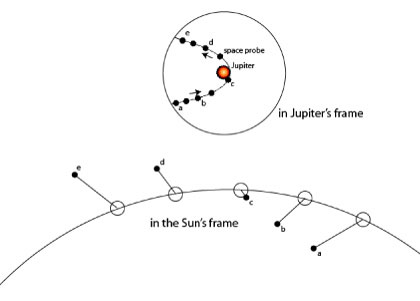
Proxima and Alpha Centauri are the Sun’s closest stellar neighbors. As they drift through the void, a mere twenty four trillion miles beneath the Earth, they exert a special fascination. Do worlds orbit these stars? Will we ever reach them? Will anyone ever stand on the surface of Alpha Centauri A “b” to witness the double sunrises that occur every 39.5-odd years?

Tiny Proxima lies a mere 15,000 AU from the Alpha Centauri AB binary pair, and moves with them through the Galaxy in a very similar direction and with a nearly identical speed. The likelihood of such a stellar configuration occurring purely by chance is less than one in a million, and based on this incredibly improbable arrangement, it has been suspected (since 1917) that the three stars constitute a bound triple system.
It’s too bad our solar system doesn’t have a companion like Proxima. If the nearest red dwarf lay 15,000 AU instead of 260,000 AU away, it would shine with the 3rd magnitude. It would be easily visible to the naked eye, and its parallax would amount to 1/120th the diameter of the full Moon. If Proxima belonged to us, rather than to Alpha Centauri, then the distances to the external stars would have likely been first measured directly by someone like Robert Hooke in the 1600s rather than Friedrich Bessel in the 1800s. We would now be avidly searching Proxima for possible terrestrial planets, and the prospects for interstellar travel would not seem quite so daunting.
Every other academic year, I teach a graduate course on astrophysical dynamics at UCSC, and one of the requirements for completion of the class is a piece of original research. During the Summer prior to the start of the class, I design a set of projects, and then we collaborate to see them through to completion.
The Alpha-Proxima Centauri system is an excellent source of projects. All three stars are extremely well characterized, and it’s interesting to look at the sorts of orbits that the configuration can support. In the Fall 2004 course, first-year UCSC graduate student Jeremy Wertheimer started to work on the following problem:
Let’s imagine that we want to send a probe to the Alpha-Proxima Centauri system, and for the sake of concreteness, let’s assume that the probe can be accelerated to a large speed by a multi-stage rocket, but that it carries no fuel of its own for the purposes of orbital insertion. Using only the principles of gravity assist and de-assist [see diagram below], and employing the gravitational fields provided by the three stars, what is the largest speed with which the probe can approach the system, and be brought into a bound orbit about any of the three stars? This maximum speed of approach serves to define a characteristic travel time to the system. How long is this time?
[Note that this is a dynamics problem falling under the general topic of multi-parameter minimization, and is not a mission proposal! There are certainly better, more effective ways to visit Alpha Centauri.]

The strategy for solving the problem is as follows: First, set up a model of the orbits of the three stars about their common center of mass. Then, define a “population” of trajectories involving possible approaches (parameterized by velocity, impact parameter, and angle of attack). Use a genetic algorithm to breed promising trajectories, and after
many generations, arrive at one that is (hopefully) near-optimal.
As soon as we set to work on the problem, we found a remarkable result in the literature. In order to optimize the trajectory, we needed to know the most accurate available orbital parameters for Alpha Centauri A, B, and Proxima. To our surprise, we discovered that the most recent papers which study the system dynamics Anosova et al. 1994, and Matthews & Gilmore 1993, both suggest that Proxima is not gravitationally bound to Alpha Centaui AB. The results in the literature imply that the three stars are independent of one another, and just happen to be experiencing a close encounter while moving in the same general direction, despite the approximately million-to-one odds.
We were astonished by this result. It just didn’t seem to make sense. In addition to having the same kinematics, Proxima also seems to have an age and metallicity consistent with those of Alpha Centauri AB. Furthermore, in order to solve our minimum travel time problem, we needed to know whether the literature result is correct. The two extant papers, written in 1993 and 1994, were published prior to the release of the highly accurate Hipparcos data. Surprisingly, as far as we can tell, nobody has attempted to use the modern measurements to see whether Proxima really is unbound from the AB pair.
We therefore realigned Jeremy’s research project to provide an updated anlaysis of Proxima’s dynamical situation. Is it bound to Alpha or not? In an upcoming post, I’ll talk about what we’ve found.

Paul Gilster over at Centauri Dreams was a bit puzzled about the 79 year interval between double sunrises that would occur for the as-yet undetected Alpha Centauri A b.
My thinking was that given the 79-year orbital period of A and B, they will have a roughly 79-year interval between conjunctions as seen from a non-co-planar planet in a
relatively close (e.g. habitable) orbit around either star. The
conjunctions would lead to a period where the stars appear very close together in the sky, hence the “double sunrises” (and double sunsets).
Upon getting Paul’s e-mail, I realized that there will be two node crossings per 79-year orbit, leading to two conjunctions per 79 year binary orbit. I’ve thus changed 79 to 39.5 in the post.
-Greg
Pingback: systemic - A Million-Year Picnic
Pingback: systemic - speculations